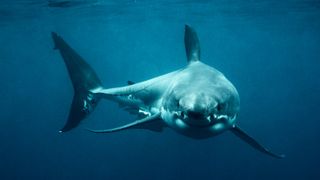
An enormous great white shark recently killed on a drumline in Queensland, Australia, will be used to help researchers discover more about the species. The gigantic female was only slightly smaller than the largest great white ever caught.
The 18.4-foot-long (5.6 meters) female white shark (Carcharodon carcharias) was found dead by the Queensland Shark Control Program at Tannum Sands, off the Queensland coast, on Aug. 10. She was pregnant with four pups when she died.
"This is the largest white shark caught in the Queensland Shark Control Program since its commencement in 1962," Tracey Scott-Holland, a spokesperson for the Queensland Department of Agriculture and Fisheries told Live Science in an email.
Reliable, verified records of large white sharks are lacking, and many historical records of behemoth sharks over 21 feet turned out to be exaggerations. The biggest white shark with a reliable measurement was caught off the coast of Massachusetts and measured 19.9 feet (6 m).
A drumline is a fishing method that uses a baited hook that's attached to a buoy and floats, with a chain anchoring it to the seafloor. The Queensland Shark Control Program uses drumlines to reduce the risk of shark bites. If a bull, tiger or great white shark — or other species associated with unprovoked bites —is caught in the Great Barrier Reef Marine Park, it is tagged, relocated and released as long as it is possible and safe to do so. Those caught outside the Marine Park are euthanized.
In Queensland, the authorities have been trialing catch alert drumlines, which send a satellite alert to a response team when a shark is caught so they can quickly tag and release the animal. But in the case of the pregnant great white shark, the team didn’t get to her in time.
"It is a shame to lose a big, reproductive animal like that," Bob Hueter, shark expert and chief scientist at OCEARCH, told Live Science in an email. "Normally, the workers are able to get out to the caught shark within a half-hour or so to tag and release the animal."
As apex predators, sharks keep the ocean's food web balanced and healthy, so a decline in their populations has a knock-on impact on many other animals. Globally, a third of sharks, rays and chimaeras are threatened with extinction.
Great white sharks are listed as vulnerable on the IUCN Red List of Threatened Species and face threats including overfishing and being caught as bycatch. The eastern Australasian population has around 750 breeding adults left.
White sharks reach sexual maturity at around 20 or 30 years old and carry between two and 17 pups every two or three years. This slow reproduction makes it difficult for the species to recover from threats.
The untimely death of a breeding female can have a significant impact on the local population. "Losing this very large, pregnant female along with her four pups is a setback for the [population's] genetic diversity and rebuilding capacity," Hueter said.
Leonardo Guida, shark conservation lead at the Australian Marine Conservation Society, told Live Science in an email that "a mixed wave of awe and sadness washed over [him]" when he heard the news.
Based on her size, "It's plausible she was born in the late 90s, when white sharks first became a protected species in Australia," he said.
But this loss could help scientists learn more about the species. "Samples were taken for research purposes, and we are collaborating with researchers from New South Wales and South Australia on several projects," Scott-Holland said. The shark's body will be used to help researchers find out more about the species' biology, genetics and populations.
Hueter — who is not involved in the analysis — is excited by what could be discovered. "Because it is exceedingly rare to be able to examine a pregnant white shark anywhere in the world, this particular shark could be very valuable for white shark science," he said.
Analyzing samples from a dead shark can provide data on the animal's feeding habits, contaminants in its waters and more.
"We're not even sure how long gestation takes in this species, and how often the females get pregnant, so examination of this 'mega momma' could help fill in some critical gaps in our knowledge," Hueter said.


评论(0)